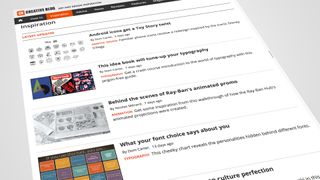7 ways to get featured by the design press
Get your work in the global spotlight by following this advice from the experts.

Whether it's a cracking new piece of flat design, an awe-inspiring work of paper craft or some eye-catching doodle art, here's no better way to get your work some recognition than having it featured on one of the big design sites.
However there are plenty of artists and designers out there trying to do the same thing, so you'll need to be canny if you want your latest project to be seen; follow these tips to give yourself a much better chance of exposure.
01. Do something different
"It’s a very democratic process on deciding what we post," reflects Emily Gosling, online editor at It’s Nice That. "We have content meetings twice a week to discuss if projects being pitched should be featured. Work that makes the cut tends to be well presented, innovative, creative (natch), recent and does something we haven’t seen before. Our readers also love anything involving tits, arses and GIFs."
02. Provide an editorial hook
"For a piece of work to appear on Creative Bloq, it has to be notable enough to stop people in their tracks," says global editor-in-chief, Dan Oliver. "Also, and this where we would differ from many sites, we really look for an editorial hook that gives a piece of work a broader appeal and takes it beyond a niche audience."
03. Make emails personal
"Anything impersonal is a real turnoff: 'Dear editor' and so on is just lazy," adds Gosling. "Address us by name, and make sure what you’re sending is relevant. For some reason I get a lot of emails about calisthenics and EDM, neither of which I’m interested in."
04. Keep it simple
"Bear in mind journalists are busy, so make life as easy as possible: attach images in the body copy rather than sending download links, and summarise the project in as concise a way as possible, rather than sending reams of text," advises Gosling. "That way we can get a gist of the project, and email or call to find out more. Include a phone number in an email and a link to your site."
05. Supply info ready to publish
Glenn Garriock of FormFiftyFive recommends taking time to find the preferred image dimensions of the blog you’re writing to. He also suggests making it easy to find additional project information: "Provide a download link with further material and a press release with soundbites, quotable comments and 'behind the scenes' or production information," he continues.
06. Give enough lead time
"If work is tied into an upcoming event – the bigger, the better – make sure we get to see it with a good amount of lead time," adds Creative Bloq’s Dan Oliver. "Also, have a quick look at the site or publication you want to contribute to. Having spent a couple of minutes browsing, unless you're delusional, you'll quickly get a feel for what a site does and doesn't publish."
07. Get tactical
"Try seeking out the contributor whose posts you most enjoy or whose work is most like your own," concludes FormFiftyFive’s Glenn Garriock. "There’s a better chance they'll feature you."
This article originally appeared in Computer Arts issue 253. Buy it here.

Thank you for reading 5 articles this month* Join now for unlimited access
Enjoy your first month for just £1 / $1 / €1
*Read 5 free articles per month without a subscription

Join now for unlimited access
Try first month for just £1 / $1 / €1
Get the Creative Bloq Newsletter
Daily design news, reviews, how-tos and more, as picked by the editors.

Julia is editor-in-chief, retail at Future Ltd, where she works in e-commerce across a number of consumer lifestyle brands. A former editor of design website Creative Bloq, she’s also worked on a variety of print titles, and was part of the team that launched consumer tech website TechRadar. She's been writing about art, design and technology for over 15 years.